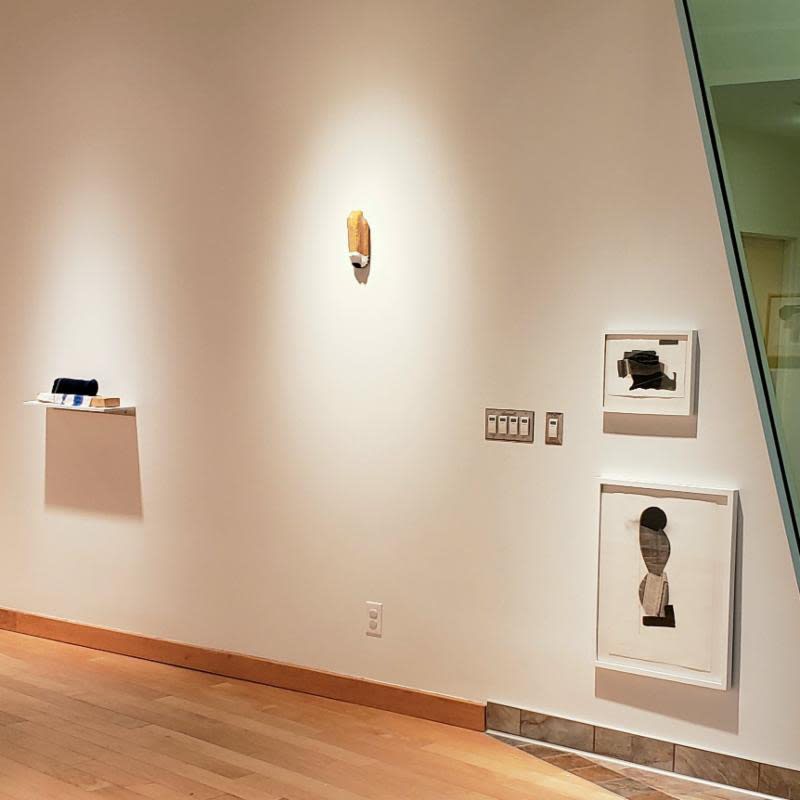Featuring work from his recent series of enigmatic sculpture and collage on paper, Jim Shrosbree: slo (roll) highlights the artist's ongoing investigation and use of abstraction to explore humanistic experience. The exhibition title, like those of his sculpture, is encrypted. It infers a call to action. The title is playful, yet pointed, particularly in a world demanding increased speed and one affected by lethargy. When pronounced, and in particular when pronounced slowly, "slo (roll)" also acknowledges an action of the body through a repetitive roll of the tongue. It, too, is a humorous exchange, but also an awakening; such simple movements have gone unnoticed.
Curated by Paul Kotula, Jim Shrosbree: slo (roll) was selected for presentation at Augsburg University by the National Council on Education for the Ceramic Arts (NCECA) and Jenny Wheatley, Director of Exhibitions at AU. It will be on view as Minneapolis hosts the NCECA 53rd annual conference March 27 - 30. Concurrently, Shrosbree's work is on view as part of the NCECA invitational/juried exhibition The Form Will Find Its Way: Contemporary Ceramic Sculptural Abstraction curated by Elizabeth Carpenter. Presented at the Katherine E. Nash Gallery, University of Minnesota, that exhibition also continues through March 30.
Curated by Paul Kotula, Jim Shrosbree: slo (roll) was selected for presentation at Augsburg University by the National Council on Education for the Ceramic Arts (NCECA) and Jenny Wheatley, Director of Exhibitions at AU. It will be on view as Minneapolis hosts the NCECA 53rd annual conference March 27 - 30. Concurrently, Shrosbree's work is on view as part of the NCECA invitational/juried exhibition The Form Will Find Its Way: Contemporary Ceramic Sculptural Abstraction curated by Elizabeth Carpenter. Presented at the Katherine E. Nash Gallery, University of Minnesota, that exhibition also continues through March 30.
Jim Shrosbree is noted for his intimate, organic, ceramic and mixed-media sculpture that suggests the figure as both a physical entity and hallowed site of being. His highly distilled imagery is formed of out of simple, yet idiosyncratic materials and placed within the context of architecture. His wall hung forms often have drawn lines or colored shapes placed behind and/or around them and many have physical linear connections, like wire, uniting the form and the wall through suspension, tension, and/or balance. Together they form a set of relationships that further each work's concept, while affirming the architectural space in which they, like those that come to view them, temporarily occupy. His free-standing pieces incorporate custom pedestals, trivet-like platforms and/or cloth coverings. The latter elude to domestic or embodied space, while inviting responses to texture memory; fake fur, nylon stockings, a piece of blanket, natural or painted wood are all common materials/elements in his work. These "stacks", as the artist sometimes refers to them, may be read as altars. Shrosbree acknowledges his Catholic upbringing and Eastern Indian influence, but they also imply a studio work space where a soiled rag, a rubber band, or a piece of felt with some stray hair, possibly from a dog, become sacred materials. For this artist, the studio is a space where the most common of things can be transformed into art.
For this exhibition, Shrosbree has also included work that extends his ideas through collage. Like his sculpture, they give a nod to Modernism, but only as a starting point. It is the conditions of contemporary life as seen through Modernism that interests him. If one hurries through this exhibition, one will miss seeing such things as light entering the empty interiors of several forms, the reflection of a work on a window that has been painted white or the underside of a form that appears to float like the assistant a magician has momentarily elevated. In an art market filled with spectacle and high production, Shrosbree's "slo" installation is not only an opportunity to reengage our curiosity, it is an opportunity to question who we are now as we face Post-humanism. "LZ" or lazy is used in several of Shrosbree's titles. As he states, lazy is an action, a moment of rest. But, how long should that action be sustained?
In 2017, Shrosbree was awarded a grant from the Pollock-Krasner Foundation and he just completed his third artist residency at Yaddo. His sculpture, paintings, and works on paper have been exhibited nationally and internationally and are included in such collections as Los Angeles County Museum of Art, Detroit Institute of Art, Daum Museum of Contemporary Art, Eli and Edythe Broad Art Museum, Des Moines Art Center, Mint Museum and University of Iowa Museum of Art. In addition to his most recent award and residency fellowship are those from the National Endowment for the Arts, Iowa Arts Council, Idaho Arts and Humanities Commission, MacDowell Colony and Watershed Center for Ceramic Art. Shrosbree earned his MFA in Ceramics at University of Montana. He is Professor of Art at Maharishi University, Fairfield, Iowa.
In 2017, Shrosbree was awarded a grant from the Pollock-Krasner Foundation and he just completed his third artist residency at Yaddo. His sculpture, paintings, and works on paper have been exhibited nationally and internationally and are included in such collections as Los Angeles County Museum of Art, Detroit Institute of Art, Daum Museum of Contemporary Art, Eli and Edythe Broad Art Museum, Des Moines Art Center, Mint Museum and University of Iowa Museum of Art. In addition to his most recent award and residency fellowship are those from the National Endowment for the Arts, Iowa Arts Council, Idaho Arts and Humanities Commission, MacDowell Colony and Watershed Center for Ceramic Art. Shrosbree earned his MFA in Ceramics at University of Montana. He is Professor of Art at Maharishi University, Fairfield, Iowa.
